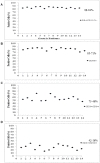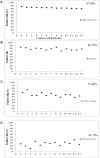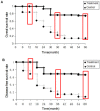Autologous tumor lysate-pulsed dendritic cell immunotherapy with cytokine-induced killer cells improves survival in gastric and colorectal cancer patients
- PMID: 24699863
- PMCID: PMC3974849
- DOI: 10.1371/journal.pone.0093886
Autologous tumor lysate-pulsed dendritic cell immunotherapy with cytokine-induced killer cells improves survival in gastric and colorectal cancer patients
Abstract
Gastric and colorectal cancers (GC and CRC) have poor prognosis and are resistant to chemo- and/or radiotherapy. In the present study, the prophylactic effects of dendritic cell (DC) vaccination are evaluated on disease progression and clinical benefits in a group of 54 GC and CRC patients treated with DC immunotherapy combined with cytokine-induced killer (CIK) cells after surgery with or without chemo-radiotherapy. DCs were prepared from the mononuclear cells isolated from patients using IL-2/GM-CSF and loaded with tumor antigens; CIK cells were prepared by incubating peripheral blood lymphocytes with IL-2, IFN-γ, and CD3 antibodies. The DC/CIK therapy started 3 days after low-dose chemotherapy and was repeated 3-5 times in 2 weeks as one cycle with a total of 188.3 ± 79.8 × 10(6) DCs and 58.8 ± 22.3 × 10(8) CIK cells. Cytokine levels in patients' sera before and after treatments were measured and the follow-up was conducted for 98 months to determine disease-free survival (DFS) and overall survival (OS). The results demonstrate that all cytokines tested were elevated with significantly higher levels of IFN-γ and IL-12 in both GC and CRC cohorts of DC/CIK treated patients. By Cox regression analysis, DC/CIK therapy reduced the risk of post-operative disease progression (p<0.01) with an increased OS (<0.01). These results demonstrate that in addition to chemo- and/or radiotherapy, DC/CIK immunotherapy is a potential effective approach in the control of tumor growth for post-operative GC and CRC patients.
Conflict of interest statement
Figures






References
-
- Jemal A, Bray F, Center MM, Ferlay J, Ward E, et al. (2011) Global cancer statistics. CA Cancer J Clin 61: 69–90. - PubMed
-
- Ottoman RE, Langdon EA, Rochlin DB, Smart CR (1963) Side-Effects of Combined Radiation and Chemotherapy in the Treatment of Malignant Tumors. Radiology 81: 1014–1017. - PubMed
-
- Palesty JA, Wang W, Javle MM, Yang GY (2004) Side effects of therapy: case 3. Gastric cancer after radiotherapy of pediatric Hodgkin's disease. J Clin Oncol 22: 2507–2509. - PubMed
-
- Boulikas T, Vougiouka M (2004) Recent clinical trials using cisplatin, carboplatin and their combination chemotherapy drugs (review). Oncol Rep 11: 559–595. - PubMed
-
- Frankenberger B, Schendel DJ (2012) Third generation dendritic cell vaccines for tumor immunotherapy. Eur J Cell Biol 91: 53–58. - PubMed
Publication types
MeSH terms
Substances
LinkOut - more resources
Full Text Sources
Other Literature Sources
Medical
Miscellaneous

